Lives Worth Living
[DVD]
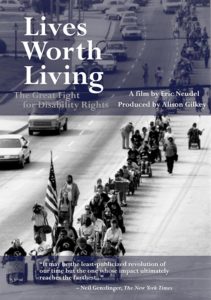
view/request
When I went to the Northampton Senior Center for a special Northampton Commission on Disability screening of Lives Worth Living I didn’t know anything about the film or its subject the disability rights movements. I was pleasantly surprised to find that the film was not just informative, but a well-crafted and incredibly moving introduction to the subject that left me eager to learn more.
At just 54 minutes in length, Lives Worth Living is too short to be more than an introduction to the story of disability rights (which it traces from the polio epidemics of the early twentieth century and the treatment of disabled veterans up to the passage of the Americans With Disabilities Act of 1990), but it makes excellent use of the time it has. We briefly learn about the discrimination and negative attitudes faced by the people with disabilities who were too often assumed to be without potential or worth. We briefly learn about the shocking maltreatment of people with mental disorders and about the Willowbrook State School and the abuses that occurred there and at similar institutions throughout the country. We learn about the Architectural Barriers Act of 1968, the Rehabilitation Act of 1973, and other early legislation, but more importantly we learn about the advocates who pushed to expand protections for the disabled, unifying diverse groups (associations for the blind, the physically handicapped, mental patients and others), and how disability rights became recognized as civil rights. And we learn about the protesters—the individuals who occupied buildings, locked themselves to bus shelters, and even crawled and pulled their way up the capitol steps to make their message heard.
Lives Worth Moving is a powerful film, well worth watching and relevant to us all. I cannot recommend it enough.
Reviewed by Ben
Tagged: Civil rights, Disability, Documentary, Film, History
Ball of Fire
by Howard Hawks
[DVD]
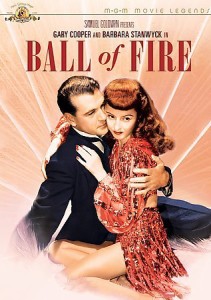
view/request
In this delightful romantic comedy Gary Cooper plays Bertram Potts, the youngest of eight professors who have lived together for years, devoting their time to the production of a new encyclopedia. When a trash collector asks the professors for help answering questions for a trivia contestd Bertram is baffled by the garbageman’s language and realizes his article on American on slang is badly out of date. In order to correct this he must leave his reference books behind in order to do some research in the field.
Bertram’s field research brings him in contact with Sugarpuss O’Shea, a witty and jocular nightclub performer portrayed by Barbara Stanwyck. Sugarpuss has no interest in helping Bertram with his research until her mob-boss boyfriend gets in trouble and she needs a place to hide from the police. What better place to hide than among these quiet and respectable professors?
Having taken refuge with the encyclopedists, Sugarpuss delights in teasing the stodgy Bertram and soon makes friends with the other professors (who, unlike Bertram, enjoy her company from the beginning). Bertram, however, worries that her presence will interfere with progress on the encyclopedia. “Now, when the Foundation launched our vessel”, he proclaims, “it very wisely followed an old rule of the sea, no women aboard. It chose a crew of single men with nothing to distract them from the course they were to sail.” Sugarpuss recognizes this as nonsense, but can’t risk a fight under the circumstances. Still, it is with evident sarcasm that she offers “to sit on her legs”.
Bertram almost redeems himself when he replies, “Make no mistake, I shall regret the absence of your keen mind”. However, he continues with, “unfortunately, it is inseparable from an extremely disturbing body.”, a statement which comes across as almost redeeming—Bertram wasn’t concerned for the sake of the other professors, but for himself. Fate will, however, keep Sugarpuss and the professor together, and despite flying wisecracks and bullets (remember the mob-boss boyfriend?) they soon grow to enjoy each other’s company.
Stanwyck’s Sugarpuss is refreshingly strong, independent, and easily the most complex character in the film. Gary Cooper’s Bertram is understated and reserved. Many of the characters come across as cartoonish, which is just what you want from the supporting characters in a screwball comedy. The dialogue is fast and witty and, of course, full of period slang, familiar and not.
By the way, Ball of FIre would later be remade as the musical A Song is Born starring Danny Kaye. The dialogue in the two films is in large parts identical, despite the different scenario and very different portrayals. Folks who have seen A Song is Born will be relieved to know that in Ball of Fire the dialogue actually makes sense!
Reviewed by Ben
Tagged: Billy Wilder, Comedy, Drama, Feature film, Howard Hawks, Jazz, Romantic comedy, Slang
The Last Days of Disco
by Whit Stillman
[DVD]
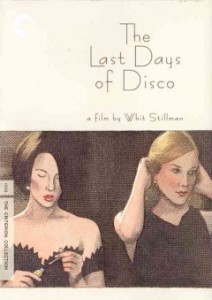
view/request
Whit Stillman’s third feature, The Last Days of Disco, is set in New York City the early 1980’s. Here we find a group of young professionals who are all, whether they are aware or not, in a period of transition. This moment of change also mirrors the current stage of the popular music (please see the title!).
Alice (Chloë Sevigny) and Charlotte (Kate Beckinsale), somewhat recent graduates of Hampshire College, are working in the lower echelons of the publishing industry. Despite having not much in common (and they can readily admit that they may not be ideal candidates for friendship), the duo decides to share a railroad style apartment with another young woman.
The tight living quarters teamed with Charlotte’s persistent insensitivity create a great deal of tension and bickering. Furthermore, there’s also tussling over potential/previous love interests. An escape from this turmoil is the local hot spot; it’s a fashionable discotheque possibly modeled in Stillman’s memory from his days hanging out at the famed Studio 54. Chris Eigeman, a Stillman mainstay, is cast as Des McGrath. McGrath is a sardonic manager at the said Manhattan club and he ultimately realizes that the owner has some sort of a shady operation going on.
When viewing The Last Days of Disco, one can’t help appreciating the dedication in creating such memorable characters and the overall writing in general. The film is filled with quick and witty dialog… most of which you cannot imagine being spoken by actual people. In one instance, Eigeman’s character begs the question, “do yuppies even exist? No one says, ‘I am a yuppie,’ it’s always the other guy who’s a yuppie. I think for a group to exist, somebody has to admit to be part of it.”
The struggle of social identity and finding one’s general placement in society underlie this brilliant comedic drama.
P.S. After a viewing, one may discover that disco does not suck!
Reviewed by Jason
Tagged: Comedy, Drama
Last Picture Show
by Peter Bogdanovich
[DVD]
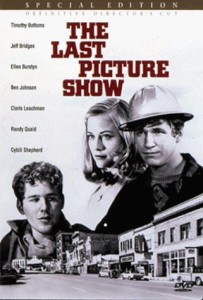
view/request
In keeping with the “New Hollywood” theme, I thought we’d take a look at another Roger Corman student and another film in the Criterion Collection’s America Lost & Found series. Following his directorial debut Targets (a brilliant “Frankensteining” of Corman stock footage of Boris Karloff and a completely new script about a local assassin), Peter Bogdanovich adapted Last Picture Show with the book’s author Larry McMurthy.
The film is set in a transitional period, both for the landscape and members of the graduating high school class, in a rural north Texas town in the early 1950’s. Timothy Bottoms, Jeff Bridges, Cybill Shephard and Randy Quaid play the local teenagers who are thinking about their futures outside of their small home town. Relationships, the military, money and taking care of family members all play important roles on these characters’ decisions. Two adult figures, Cloris Leachman and Ben Johnson, both won Oscars for their performances in supporting roles.
Robert Surtees’s soft black and white cinematography over the dusty roads and old shop signs hang a general feeling of loneliness over Last Picture Show. Bogdanvoich’s subtle humor, rich character drama and calculated pace, earn him comparison to the French master François Truffaut. He would also continue to look to the past, mostly filming in black and white, in years to come with films like Paper Moon, What’s Up Doc? and Nickelodeon.
In The Last Picture Show, we can feel that change will come in this part of Texas and that Red River shall inevitably have its final curtain.
Reviewed by Jason
Tagged: Comedy, Drama, Feature film
Richard Pryor: Omit the Logic
[DVD]
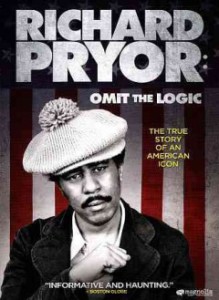
view/request
Marina Zenovich’s film is an excellent portrait of comedian and actor Richard Pryor. We see all the brilliance, unflinching confidence, missteps, self-destruction, triumphs and pain. Omit the Logic hits the ground running with Pryor’s earliest televised stand-up appearances with a routine resembling what Bill Cobsy was up to in the early 1960’s. However, after a disastrous set in Las Vegas, Pryor disappears and later resurfaces in San Francisco as a completely unique, uncensored entertainer.
The film highlights much of Pryor’s autobiographical material. After a fair share of belly laughing at these classic, personal routines about his childhood, relationships with women and drug use, the documentary leads us to Pryor’s difficult past. Contemporaries, colleagues and followers such as Bob Newhart, Paul Mooney, Dave Chappelle, Mel Brooks, Robin Williams and Whoopie Goldberg contribute anecdotes to Pryor’s perplexing story. It’s both noble and heartbreaking how Richard Pryor persisted to find humor in the darkest of places.
Reviewed by Jason
Tagged: Comedy, Documentary, Stand-up
Bored To Death
[DVD]
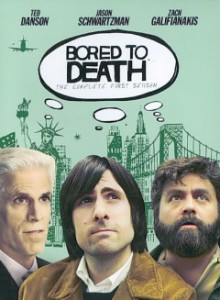
view/request
Jonathan Ames casts Jason Schwartzman as his alter-ego “Jonathan Ames” in the comedic, sleuth series Bored To Death. Ames is a young author from Brooklyn with motivational issues struggling to complete his second novel. One evening he turns to famed pulp writer Raymond Chandler for inspiration. After completing Farewell My Lovely, he proceeds to take out an advertisement on Craigslist boasting his reasonable rates and unlicensed detective services.
Each episode follows Schwartzman on madcap cases, painful romantic encounters and surprisingly tender buddy-buddy moments with brilliant co-stars Ted Danson and Zack Galifiankis. The show also features cameos appearances from John Hodgman, Patton Oswolt and Kristen Wiig.
Reviewed by Jason
Tagged: Comedy, Mystery, TV series
Judex
[DVD]
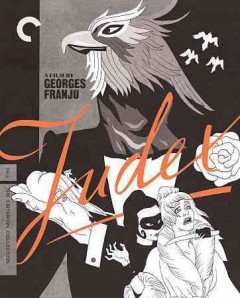
view/request
I tend to be someone who knows what he’s looking for in the stacks and will often go in with a list. We can’t always be a slave to structure though. Judex is a film I checked out based solely on the intriguing box cover. It also is a part of the Criterion Collection… so, I knew I was in for something interesting.
This 1963 French movie is an homage to a 1916 silent film of the same name. Set at the time of the original, Judex hits the ground running with a mysterious blackmail letter, a murder, strange sci-fi/occult touches and a stoic, caped man. Countless twists and turns, masks, hidden identities, a circus, knives and a lovable detective color this suspenseful caper. Furthermore, Judex is photographed in the most brilliant black and white with stylish camera angles that would make any film nerd’s heart have serious palpitations.
It pays to sometimes take chances with movies; going in blindly. However, I’ve done the work for you already on this one. So, go ahead and enjoy George Franju’s Judex!
Reviewed by Jason
Tagged: Feature film, Mystery
Sensation: The Story of Tommy
[DVD]

view/request
I first heard the Who’s Tommy as a teen or pre-teen after borrowing a copy from the Russell Library in Middletown, CT. That’s really the age to delve into both the angst and sensitivity of the Who… in fact, it’s the best time to explore music in general as that feeling of the world opening up to you begins. What followed this library trip was a huge Who obsession and, after the realization that Pete Townshend and I share a birthday, I was convinced there was some sort of connection between myself and the music. I’m sure I wasn’t the only teenager who felt this way.
Martin R. Smith’s documentary doesn’t focus on the stellar musicianship of the band (that coverage can be found anywhere… I mean, listen to a Who album!); rather, it leads the viewer through Tommy‘s high concepts and tells the story of a band in a state of transition. It is evident we have a “pre” & “post”-Tommy Who for the history books. Tommy, an album many consider as the first “rock opera”, legitimized Pete Townshend as a true composer, gave Roger Daltry the confidence to stand out front as the powerful lead singer (often in fringe), took the Who to opera houses around the world and turned the band into a stadium rock monster.
The film features interviews with Pete Townshend, Roger Daltry, John Entwhistle (archival), Keith Moon (archival), former Who manager Chris Stamp, Tommy album artist Mike McInnerney, Who biographers and a couple Rolling Stone Magazine nerds. It also has audio recordings of Townshend demos and several live performance clips.
Reviewed by Jason
Tagged: Documentary, Rock music
The Art of the Steal
by Don Argott
[DVD]
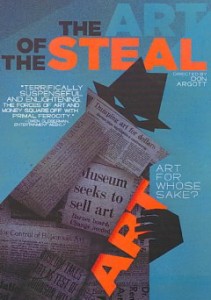
view/request
The Art of the Steal is a documentary that addresses the issue of public ownership of artwork. Don Argott’s film focuses on a much heated conflict in the state of Pennsylvania concerning the Barnes Collection and Foundation. Albert Barnes, a wealthy chemist turned art collector, acquired one of the most stunning Impressionist and Post-Impressionist collections in the world. He housed this uniquely curated collection along with a school as the Barnes Foundation in Lower Merion, PA. After his death in 1951, it was made clear by his will that the collection would not move nor would any of the work be sold under any circumstances.
Here’s where it gets interesting… Barnes’s wishes were not shared with many of the powerful Philadelphia politicians and society members. As management changed hands, the film highlights political nonsense and a long spiral of undermining of the collection’s owner over a sixty plus year period. Many issues arise in the dealings with the collection of art (now worth an estimated twenty-five billion dollars) and we really don’t have a clear cut understanding of whose interests are actually being served.
The Art of the Steal is a fascinating look into both the political and art worlds.
Reviewed by Jason
Tagged: Art, Documentary
Evocateur: The Morton Downey Jr. Movie
[DVD]
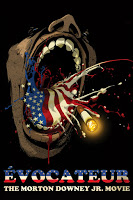
view/request
Saying Morton Downey Jr. was a complex man would be the understatement of the century. Son of a famous singer, Jr. began his career in show business as a vocalist himself. He had a small hit with in 1958 with the haunting tune “Boulevard Of Broken Dreams”. He later worked in radio and eventually became involved with the world of sports by first buying an American Basketball Association team and later co-founding the World Baseball League.
What brought Morton Downey Jr. national attention was his short run on the syndicated Morton Downey Jr. Show based out of New Jersey. The host who grew up hanging around the Kennedy family, became a loudmouth, conservative screamer on his late 80’s program. The documentary pulled many clips that made the air where Downey Jr. gets in audience members faces and says some of the most horrific and offensive things you will ever hear in your life. His show seems to be pure theater and unfortunately it paved the way for future trash television such as the Jerry Springer Show.
Like him or not, Evocateur is a massively entertaining film. It’s an excellent documentary of the strange life and quick rise and fall of a man whose life was filled with controversy.
Reviewed by Jason
Tagged: Documentary, Politics
The We and The I
[DVD]
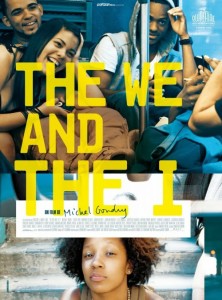
view/request
Director Michel Gondry is mostly know for his heady, comedic films with cunning in-camera effects such as Eternal Sunshine of the Spotless Mind &The Science of Sleep and innovative music videos from Björk, Beck and the White Stripes. In The We and the I, Gondry scales back and tells a story via a bus ride through the Bronx. The French director workshopped this script with a group of teens over the course of three years and the result is this wonderful film.
We see the complex dynamics of high school relationships as we join a group of students after their last day of classes. There’s bullying, gossip, swagger, flirting, fighting, some genuinely funny conversations and many heartfelt moments, too. Throughout, the dialog is natural; we almost feel as though we’re watching a a documentary at times.
Despite this austere approach to filmmaking, Gondry’s presence is still felt with the occasional use of non-digital effects. A small boombox shaped bus rides around town at the intro. Later, we see an interesting scene where he superimposes a pizza shop directly through the window of the city bus. These moments perfectly interject surrealism and introduce lightness into this very realistic movie.
Reviewed by Jason
Tagged: Feature film, New York City
A Glimpse Inside the Mind of Charles Swan III
[DVD]
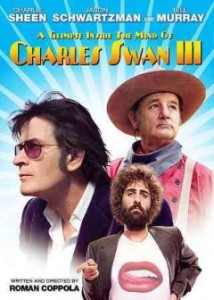
view/request
Charlie Sheen, Jason Schwartzman, Katherine Winnick, Patricia Arquette, Aubrey Plaza and Bill Murray star in this dark comedy about a graphic artist going through a painful breakup and life crisis. Charles Swan (played by Charlie Sheen) is a Brandy Alexander drinkin’ guy who has eggs and bacon decals on his old roadster, but also dreams up wild visions of soft shoeing at his own funeral, singing a duet in Portuguese on television and being attacked by models wearing Native American garb. He simply can’t distinguish reality from fantasy.
Roman Coppola, yes son of Francis Ford and brother of Sofia, is the writer/director. The film is a homemade affair with Coppola using his house and office as key locations. He also worked as the director of photography on the picture. A Glimpse Inside, though never stating such, seems to be set during a groovy time in 1970’s: airbrush, velvet suits, cool hair, shades, snazzy record album jackets, etc. In addition, the character of Charles Swan is loosely based on a few airbrush wizards from the L.A. art scene and fittingly, Swan’s studio features the work of several of these artists (including Charles White III).
The film blends off beat comedy, staged fantasy and drama. Also, be sure to listen for Liam Hayes’s brilliant score.
Reviewed by Jason
Tagged: 1970s, Artists, Feature film












